Exploring Dubai's Unique Residential Neighborhoods
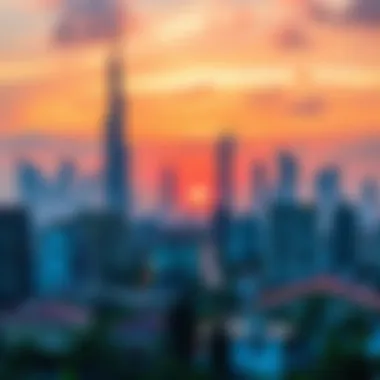
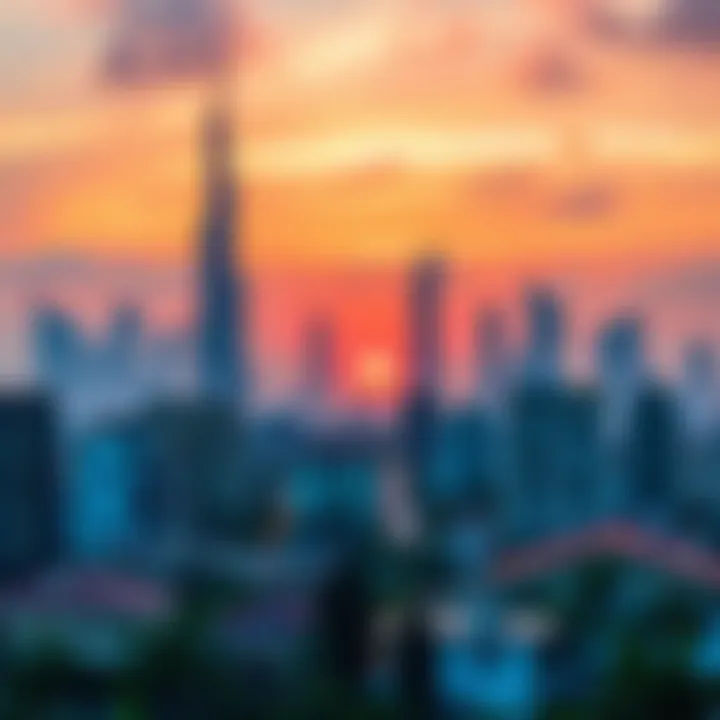
Intro
Dubai, a city that dances between modernity and tradition, is not just a glittering skyline or extravagant shopping malls. The true essence of Dubai unfolds in its residential cities, where diverse communities thrive amidst rich culture and engaging lifestyles. This article offers a detailed journey through Dubai’s neighborhoods, revealing their distinctive traits and the unique offerings they present to residents and visitors. From luxurious districts to up-and-coming areas, the array of lifestyles available can be as varied as the populations that call them home.
The exploration will touch on vital aspects such as local culture, community vibes, amenities, and more. There's a lot to glean from the tapestry of life in Dubai that extends beyond its well-known attractions. This guide aims to provide insights not only into what makes different areas tick but also offers practical advice for navigating each neighborhood, ensuring that whether you're a resident, an expatriate, or a curious tourist, you leave with a rounded understanding of the city’s intricate residential landscape.
Local Culture and Community
Dubai's charm lies in its multicultural fabric, where people from diverse backgrounds weave together a community full of life and vibrancy. Each residential area boasts its own set of cultural festivals and events that reflect the rich heritage of its inhabitants.
Cultural Festivals and Events
When it comes to cultural celebrations, Dubai is never short of surprises. From the dazzling Dubai Shopping Festival to the soulful Eid Al Fitr celebrations, there’s something for everyone. Neighborhoods often host local events, where residents can enjoy exhibitions, art displays, and food festivals that showcase their culture and tradition. For instance, in areas like Al Fahidi, historical art shows are common, drawing locals and tourists alike to experience Dubai’s past through art.
Community Engagement and Activities
Engagement within the community is crucial. Many residential districts encourage residents to participate in community activities, ranging from beach clean-ups to local charity fairs. It helps foster connections between residents, promoting inclusivity and cooperation. Take, for example, the Jumeirah neighbourhood, where weekly markets sprout up, echoing laughter and chatter while residents shop for local produce or handmade crafts. The sense of belonging here is palpable, and it’s this engagement that makes living in Dubai an enriching experience.
"Community is where you find support, friendship, and connection - and in Dubai, every neighborhood offers its unique take on that.”
Lifestyle and Amenities
Life in Dubai's residential areas goes hand-in-hand with an abundance of amenities that cater to every age and interest. The lifestyle offered is nothing short of extraordinary, making it a magnet for those seeking both luxury and comfort.
Dining and Culinary Experiences
Dining in Dubai is a world tour of cuisines wrapped within a few city blocks. No matter where you live, culinary experiences await. The Barsha Heights area, known for its diverse foodie scene, is teeming with restaurants serving everything from local Emirati dishes to fusion options. It’s not just about eating; it’s about experiencing different cultures through food - a vibrant Hispanic corner here, a classic Italian trattoria there. Each bite tells a story.
Recreational and Entertainment Options
In addition to food, the recreational options can elevate your lifestyle. Parks, fitness centers, and malls with entertainment complexes dot the landscape. Areas like Dubai Marina offer stunning waterfront views, perfect for jogging or casual strolls. Families often flock to these spaces for picnics, while singles might enjoy the nightlife options, such as rooftop lounges or live music venues. The key is variety, ensuring every demographic finds their niche in the bustling social scene of the city.
Overview of Residential Cities
In the bustling metropolis of Dubai, residential cities play a pivotal role in shaping the urban landscape. These areas offer more than just homes; they are vibrant communities infused with culture, amenities, and connectivity. Exploring residential cities in Dubai is essential for a myriad of reasons, especially for residents, expatriates, tourists, planners, and marketers who seek a deeper understanding of the city's unique fabric.
The benefits of understanding these locations extend to several key elements:
- Community Dynamics: Each neighborhood encapsulates a special identity that reflects the cultural diversity of its residents. From the family-oriented suburbs to modern high-rise condominiums, knowing these distinctions can help individuals find their perfect niche in the city.
- Accessibility: Dubai's residential cities come with a comprehensive infrastructure, allowing easy access to main highways, public transportation, and recreational facilities. This can substantially enhance the quality of life for those residing in these areas.
- Amenities: The wealth of amenities varies from one neighborhood to another. Some boast luxury shopping malls and fine dining, while others focus on family-friendly parks and educational institutions. Understanding these offerings helps families and individuals to make informed decisions about where to settle down.
- Investment Potential: For investors and marketers, knowing what makes a residential area appealing can lead to savvy business decisions. Areas on the rise, like Dubai South, present different opportunities than established neighborhoods such as Palm Jumeirah or Downtown Dubai.
Overall, the importance of dissecting residential cities in Dubai lies in comprehensively understanding not just where one might live, but how each neighborhood weaves into the larger tapestry of life in the city. With the skyline changing daily and new communities emerging, an informed perspective enables individuals to engage with the city intelligently.
Defining Residential Cities
Residential cities in Dubai can be understood as designated urban locales primarily aimed at housing and living. Each area serves its own distinct purpose, designed around the needs and preferences of its residents. They can vary widely in terms of size, style, and demographic focus.
Etymologically, "residential" implies a place where people reside, but in Dubai, it takes on additional significance. Here, residential cities often blend commercial and recreational spaces, which means life isn’t confined to home but extends into vibrant community hubs. Key examples include places designed for luxury living like Dubai Marina or more family-centric environments like Arabian Ranches.
Furthermore, these areas symbolize Dubai's ambitious development agenda, showcasing the emirate's focus on sustainability, luxury, and modern living. It is this mix of functionality, lifestyle choices, and cultural relevance that encapsulates the essence of what makes a residential city in Dubai.
Historical Context
To truly appreciate the residential cities of Dubai today, it's crucial to take a step back in time to grasp their historical evolution.
In the early days, Dubai was a modest fishing village, where people lived in simple structures along the coast. As the city transitioned to a trade hub in the mid-20th century, significant foreign investments laid the groundwork for a more developed urban environment. The discovery of oil marked a pivotal turning point, leading to rapid urbanization and the establishment of new residential neighborhoods.
The late 20th and early 21st centuries saw various development phases in Dubai, focused primarily on creating attractive living spaces for international expatriates and affluent locals. Designed to cater to an increasingly diverse population, these neighborhoods began to integrate luxury amenities, architectural innovation, and a commitment to a cosmopolitan lifestyle. The influence of international design aesthetics can be seen in areas like Jumeirah Beach Residence, where residential life is seamlessly intertwined with leisure and luxury.
Today, Dubai's residential cities stand as a monument to its visionary transformation. They attract not just residents but also investors keen on tapping into the growing real estate market.
It's a reflection of a city that learned to adapt and thrive on fluctuations, creating dynamic spaces that offer residents the comforts of home combined with the vibrancy of city life.
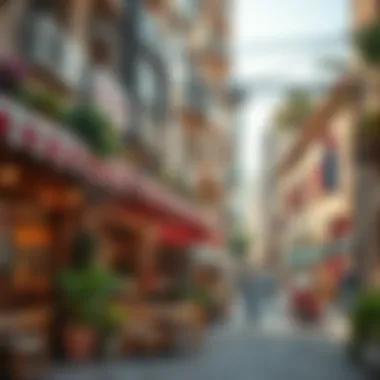
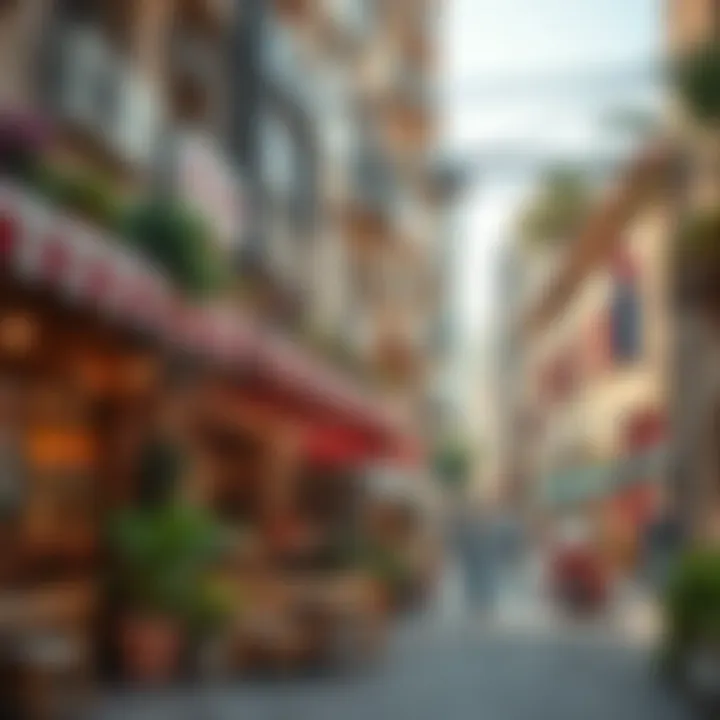
Key Characteristics of Dubai's Residential Areas
Understanding the unique aspects of Dubai's residential areas offers valuable insight into what makes these communities extraordinary. From the eclectic architectural styles to the thriving communal infrastructure, these characteristics not only define the neighborhoods but also shape the experiences of those who call them home. In Dubai, residential living is more than just acquiring a space to live; it’s about embracing a lifestyle rich with amenities and opportunities. This section explores the pivotal features that set apart Dubai's residential areas, aiding potential residents, expatriates, and tourists in navigating their choices.
Architectural Diversity
Dubai is a patchwork of architectural brilliance, where tradition meets modern innovation. The city's skyline is famous for its skyscrapers, such as the Burj Khalifa, but its residential neighborhoods are equally diverse. You can find everything from contemporary glass-clad buildings to traditional Arabesque designs. This melding of styles isn't just for show; it reflects a deeper cultural narrative.
- Embracing the Past and Future: Many communities incorporate elements of Islamic architecture, creating a connection to the rich history of the region. On the flip side, newly developed areas showcase futuristic designs that symbolize the city’s ambitious vision.
- Symbolic Complexity: The architecture varies significantly by area, revealing community values and lifestyle preferences. For instance, low-rise villas in neighborhoods like Jumeirah mirror a family-oriented setting, whereas towering apartments in Dubai Marina appeal to those who thrive in a fast-paced, upscale environment.
The result is a visual feast that appeals to both residents and visitors. When one strolls through neighborhoods like Al Fahidi, it's like stepping back in time, while the futuristic vibe of Dubai Design District inspires creativity.
Community Infrastructure
Community infrastructure is crucial for enhancing residents’ quality of life. In Dubai, the focus on creating well-rounded neighborhoods is apparent in the availability of essential services and facilities:
- Accessibility: Many residential areas are designed with convenience in mind. Local shopping centers, medical facilities, and schools are often just a stone’s throw away, making daily life easier.
- Public Services: The government invests heavily in maintaining and improving public services. This includes waste management, street cleaning, and public safety, ensuring a clean and secure living environment.
- Social Spaces: Public parks, community centers, and sports facilities are integral to community infrastructure. They provide residents with opportunities to socialize, recreate, and engage with one another, fostering a sense of belonging.
The thoughtful layout and design of these facilities are not just functional; they play a significant part in creating a vibrant community spirit.
Green Spaces and Recreational Areas
Amidst the glitz and glam of the city, greenery and open spaces offer a breath of fresh air. Dubai’s residential areas are increasingly incorporating parks and recreational spaces that serve as oases for relaxation and social interaction:
- Parks and Gardens: Locations like Al Barsha Pond Park provide residents a place to stroll, jog, or picnic with family. These green spaces are vital, especially in a city where the urban heat can be intense.
- Recreational Facilities: Whether it’s the sprawling beaches of Jumeirah or sports clubs sprinkled throughout the residential cities, the focus on leisure activities enhances the overall living experience. Emirati culture places great importance on outdoor leisure, and it’s reflected in the countless facilities available.
- Environmental Initiatives: Efforts are in place to create sustainable, eco-friendly neighborhoods. Green building standards ensure that new developments incorporate environmentally friendly technologies, promoting sustainable living habits among residents.
In summation, the features of Dubai's residential areas reveal a careful balance between modernity and tradition, convenience and community, livability and luxury. Understanding these key characteristics is essential for anyone considering a move or visit to this dynamic city.
Affluent Neighborhoods
Affluent neighborhoods in Dubai are not just places where the well-off reside; they are microcosms of luxury, innovation, and a lifestyle that many aspire to. These areas stand out due to their unique offerings, catering to high net worth individuals and families seeking security, exclusivity, and convenience. The importance of these neighborhoods within Dubai's residential landscape cannot be overstated as they encapsulate the city’s rapid development and the dreams of numerous expatriates and locals alike.
Being part of an affluent neighborhood often means more than just living in a fancy home. It involves access to top-tier amenities—think high-end restaurants, designer stores, and private beaches. Furthermore, these areas have well-planned community layouts that prioritize the needs of their residents, offering not just housing but a vibrant lifestyle.
Palm Jumeirah
Palm Jumeirah is perhaps the most iconic suburb in Dubai and a true testament to ambitious urban planning. This man-made island resembles a palm tree from above, adorned with stunning villas and luxurious resorts. It’s famed for its upscale residences that offer picturesque views of the Arabian Gulf, creating a sense of sanctuary away from the hustle and bustle of the city.
Owning property here is often considered a status symbol. Residents enjoy a plethora of exclusive services, from private beach access to luxury spas, all while being a short distance from the vibrant nightlife of Dubai. On a typical day, you might find yourself lounging by the pool at the Atlantis, followed by a gourmet dinner at Nobu.
"Palm Jumeirah offers a lifestyle that redefines luxury, with amenities that feel just a heartbeat away."
Dubai Marina
Dubai Marina is where modernity meets leisure. Envision a skyline dotted with towering skyscrapers reflecting in the azure waters, coupled with a vibrant ambiance spiced up by its bustling promenade. The Marina is particularly significant for its cosmopolitan charm, drawing in a diverse crowd from across the globe.
This neighborhood offers an array of high-rise apartments that boast breathtaking waterfront views. Many residents take advantage of the Marina Walk, a charming boulevard lined with cafes and boutiques, perfect for evening strolls or casual meet-ups. The accessibility to water sports and leisure activities further enhances its attractiveness, making Dubai Marina a living canvas of life and lifestyle.
Downtown Dubai
Downtown Dubai is often regarded as the heart of the city. This neighborhood houses the iconic Burj Khalifa, the world’s tallest building, and Dubai Mall, one of the largest shopping centers. The area is a blend of culture and commerce, flourishing with life from morning till night.
Living in Downtown Dubai offers a unique urban experience. Residents are often encompassed by luxury, with premium retail outlets, fine dining establishments, and art installations dotting the area. The vibrant arts scene and community events make this a dynamic place to live, appealing particularly to young professionals and families who appreciate a mix of work and play.
Emerging Residential Markets
The concept of emerging residential markets in Dubai has gained momentum, becoming essential to understanding the evolving urban landscape of the city. As Dubai grows, new areas are earmarked for development, shaping the future of residential living. These emerging markets not only attract investors but also offer a breath of fresh air for those seeking affordable alternatives to the well-established neighborhoods. What’s interesting about these areas is how they combine practicality with innovation, and a unique charm that resonates with both locals and expatriates.
Emerging markets typically boast several advantages:
- Affordability: Homes in these areas are often more budget-friendly compared to their affluent counterparts, making them appealing to first-time buyers or renters.
- Modern Amenities: With new developments come modern technologies and amenities designed with convenience in mind. Urban planners often integrate smart home technologies and eco-friendly features.
- Community Feel: Many of these neighborhoods focus on creating a sense of community through parks, social spaces, and recreational activities.
However, potential residents should also weigh considerations such as commuting times and the availability of established services. As these areas develop rapidly, they may lack the same level of infrastructure that more seasoned neighborhoods provide. Nonetheless, for those who are willing to navigate these potential hiccups, it’s clear that Dubai’s emerging residential markets hold exciting prospects.
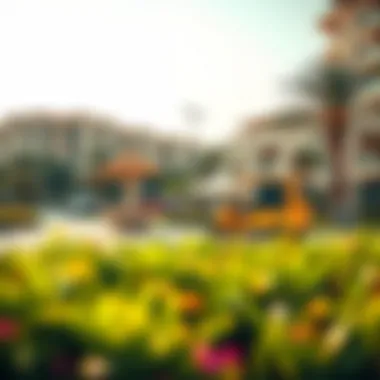
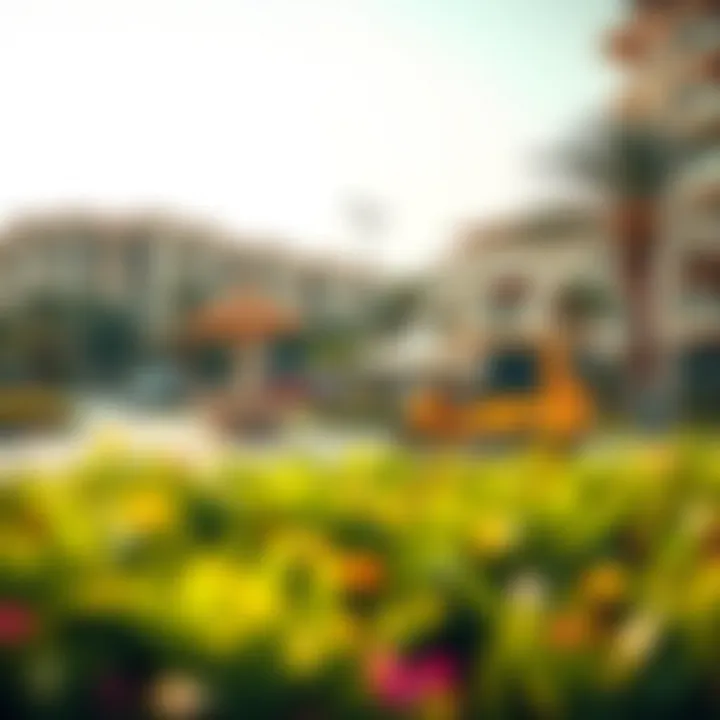
Dubai South
Dubai South represents one of the most ambitious projects in the emirate, envisioned as a fully integrated city. This area is located near the new Al Maktoum International Airport and is designed to host both commercial and residential zones. The significance of Dubai South cannot be overstated—this area is seen as a hub for logistics and aviation industries, which runs in tandem with its residential appeal.
The benefits of living in Dubai South include:
- Proximity to the Airport: Ideal for frequent travelers and expatriates.
- Ease of Access: Well-connected via roads and future rail links.
- Diverse Property Types: A range of options from villas to apartments caters to different tastes and budgets.
Mohammed Bin Rashid City
Mohammed Bin Rashid City stands out as an innovative residential and leisure destination, named after Dubai’s ruler. This project aims to bring the lush greenery missing in many urban areas back to the city. Envisioned to house the world’s largest shopping mall, this area combines luxury living with vibrant community life.
Key highlights include:
- Green Spaces: Parks and themed gardens designed according to international standards.
- Cultural Centers: Art galleries, museums, and educational institutions enrich the community's cultural fabric.
- Lifestyle Offerings: High-end dining and shopping experiences beckon.
Al Furjan
Al Furjan has evolved into a sought-after residential area, capturing the attention of families and young professionals alike. Situated close to the Discovery Gardens and Jebel Ali Village, it showcases a blend of affordable housing and community spirit. The neighborhood enjoys a reputation for being family-friendly, with well-developed amenities and accessible facilities.
Features that make Al Furjan appealing include:
- Vibrant Community: Social gatherings and events foster a neighborhood spirit.
- Retail and Dining Options: An array of shops and options to suit diverse tastes can be found here.
- Accessibility: Major highways and public transport facilitate easy movement throughout the city.
The emergence of these residential markets in Dubai is not simply about housing; it embodies a vision for community, connectivity, and compatibility with modern lifestyles.
As Dubai continues to flourish, keeping an eye on these markets is essential. They offer a glimpse into the future of living in this vibrant city, promising a dynamic blend of innovation, affordability, and a strong sense of community.
Lifestyle and Amenities
The lifestyle and amenities offered in Dubai's residential cities play a pivotal role in defining the experiences of both residents and visitors. Dubai is often viewed through the lens of luxury, but even the most humble neighborhoods boast a wealth of amenities that enhance daily living. Understanding this aspect can help individuals choose neighborhoods that best align with their personal preferences and needs. The integration of lifestyle options and amenities fosters a vibrant community atmosphere, making the city not just a place to live, but a home.
Dining and Nightlife
Dining in Dubai is akin to embarking on a global culinary journey. From bustling street vendors to upscale restaurants, the city offers a smorgasbord of options. Certain neighborhoods, like Al Barsha, are famous for their casual eateries where one can savor authentic Lebanese shawarmas or Thai curries. For those looking to indulge in something more upscale, Downtown Dubai features high-end establishments that serve culinary masterpieces created by renowned chefs.
Nightlife is another integral piece of the puzzle. Dubai Marina and Jumeirah Beach Residence (JBR) are well-known for their lively bars and trendy clubs that stay abuzz until the early hours. Here, one can find a bar with a stunning view of the skyline or a club that draws famous DJs. Yet even quieter neighborhoods offer cozy pubs for those who prefer a laid-back atmosphere. One can never run out of options in this ever-evolving scene.
Shopping Venues
When it comes to shopping, Dubai is nothing short of a paradise. From sprawling malls to vibrant souks, the choices are countless. The Dubai Mall, with its luxurious brands and entertainment options like an aquarium, offers a complete package for shopping enthusiasts. In contrast, the Gold Souk in Deira presents a traditional flavor, where one can haggle for intricate gold jewelry and spices.
Local markets, particularly in neighborhoods like Karama, offer affordable clothing and artisan crafts, catering to those on tighter budgets. As consumers become increasingly conscious of sustainability, many residential areas also see the rise of eco-friendly boutiques, creating an exciting blend of choices. The shopping experience in Dubai transcends mere consumerism; it often intertwines with cultural experiences, giving residents a unique sense of belonging.
Educational Institutions
Education in Dubai reflects its global nature, housing a range of institutions that cater to various needs. The city boasts numerous international schools, offering curriculums such as British, American, and IB, attracting families from diverse backgrounds. Neighborhoods such as Arabian Ranches and Dubai Hills Estates often host highly regarded schools, making them appealing options for expatriate families.
Moreover, higher education institutions like the American University in Dubai and Dubai International Academic City provide ample opportunities for university-level education, further enriching the city's educational landscape. As families consider their long-term plans, the proximity to quality educational offerings can significantly influence their housing decisions.
"Investing in your community’s educational resources is akin to planting seeds for future growth."
Transportation and Connectivity
Transportation in Dubai functions as the backbone of the city, threading through its urban tapestry and linking various residential areas, commercial hubs, and cultural landmarks. With such a multifaceted landscape, understanding transportation and connectivity is essential not just for residents but also for expatriates and tourists. It's a major factor influencing their moving decisions and overall lifestyle quality. People who know how to navigate the city can save time, stress, and money.
Public Transport Systems
Dubai's public transport is among the most advanced in the world, designed to accommodate the city’s exponential growth. The Road and Transport Authority (RTA) has created various options that make travel efficient and affordable. Here are key elements:
- Metro System: One of the jewels of Dubai’s public transport, the Metro covers most of the major residential areas. With fully automated trains, it makes commuting quick and smooth. Stations are generally clean and well-maintained, contributing to an overall pleasant experience.
- Buses: Complementing the Metro are the extensive bus networks that reach every corner of the city. Buses operate frequently, and many people rely on them for their daily commutes.
- Water Transport: Don't overlook the abras and water taxis. These modes of travel offer a scenic view and are especially popular among tourists and residents alike who wish to navigate the waterways.
- Taxis and Rideshares: Traditional taxis are plentiful, but rideshare options like Careem and Uber have gained traction. They’re convenient and often preferred for their ease of use and flexible payment options.
Public transport not only cuts the commute time but also offers a more environmentally-friendly choice.
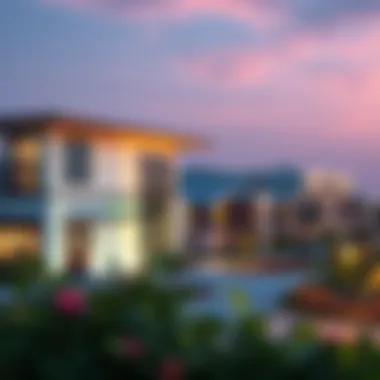
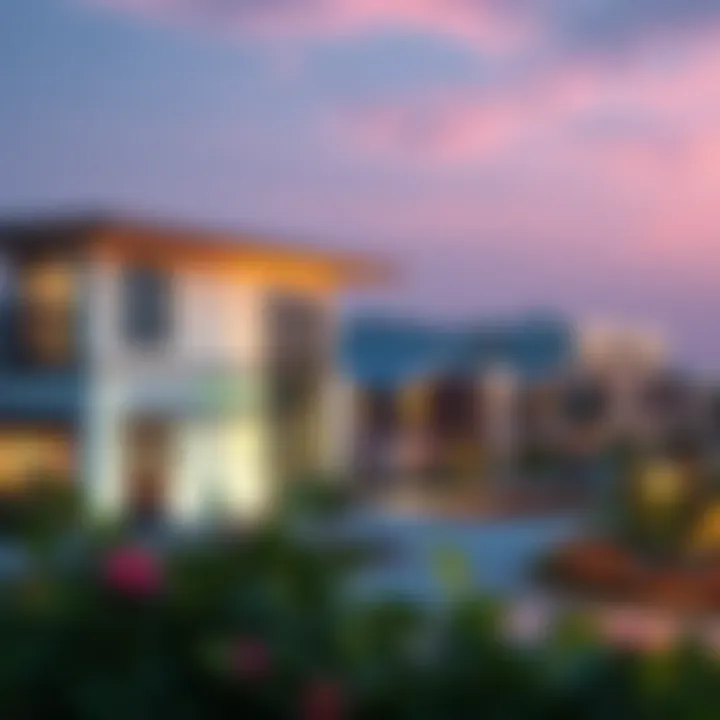
Road Network Dynamics
When one thinks about transportation, roads are what normally come to mind. Dubai boasts an intricate road network designed to handle the heavy traffic that comes with a booming population. It’s worth exploring some notable considerations:
- Major Highways: Sheikh Zayed Road is often considered the main artery of the city, running parallel to the coast and connecting various neighborhoods. It’s always buzzing with activity, serving thousands of commuters every hour.
- Roundabouts and Interchanges: The complexity of interchanges can catch newcomers off-guard. While they might look daunting, they are engineered for efficiency, reducing travel time between various nodes in the city.
- Traffic Management: With traffic enforcement measures in place, like speed radars and regular checks, road safety is taken seriously here. Still, during peak hours, some may find themselves in a bit of a traffic jamb, so planning ahead is wise.
In summary, the transportation system in Dubai is not just a means of getting from point A to point B; it carries with it a wealth of cultural interaction and connectivity. This is essential for fostering community ties and enriching the urban experience. Understanding these elements can greatly enhance your appreciation of life in this vibrant city.
"Efficient transportation is the thread that weaves together the fabric of life in Dubai, from the bustling expat communities to the lavish lifestyle of affluent neighborhoods."
For detailed insights or updates, consider checking the
Road and Transport Authority for latest transport options and schedules.
Helpful resources for further reading include Wikipedia and Britannica.
All in all, navigating the wild landscape of Dubai's roads and public transport can be like riding a roller coaster, sometimes thrilling, sometimes a bit daunting, but ultimately rewarding.
Cultural Influences in Residential Design
In the bustling metropolis of Dubai, residential design is not merely about bricks and mortar; it's a canvas for showcasing culture and identity. Cultural influences play a crucial role in how communities are structured and how residents interact within those spaces. From traditional Emirati aesthetics to modern trends, the blend of influences from various cultures enhances the livability and charm of neighborhoods.
Understanding these influences provides insight into Dubai’s unique residential environment, illustrating its commitment to honoring diverse traditions while embracing progressive change. Furthermore, considering these factors can lead to better-planned spaces that reflect the community’s values and aspirations.
Cultural Integration and Symbolism
The concept of cultural integration is prominently visible in Dubai’s residential design. Neighborhoods are often a mosaic of international styles and practices, reflecting the diverse heritage of their residents. For instance, you might walk through a community where you see traditional wind towers, a hallmark of Emirati architecture, alongside sleek, modern apartments inspired by Western styles. This fusion speaks volumes about the city’s openness and willingness to integrate various aesthetics.
Symbolism in residential architecture is also noteworthy. Many buildings in Dubai embody significant cultural markers:
- Calligraphic designs that honor the Arabic language.
- Patterns inspired by Islamic art, which feature geometric intricacies that tell stories of the past.
- Color usage that may reference local flora, further grounding the design in its geographic context.
By intertwining such elements into the fabric of residential areas, Dubai creates spaces that tell the story of its residents. It not only reflects the heritage but cultivates a sense of belonging which is pivotal for community coherence.
Art and Public Spaces
Art within public spaces serves as a bridge connecting diverse cultures inhabiting Dubai. Sculptures, murals, and interactive installations grace many communal areas, which makes them vibrant and attractive for residents and visitors alike. This practice promotes art appreciation and encourages local participation.
Public art can be seen in several neighborhoods, enhancing the urban experience:
- In Dubai Marina, striking installations reflect the area's luxury and creativity.
- The Dubai Design District acts as a canvas for artistic expressions, showcasing the works of local and international artists.
Such initiatives not only beautify the community but also stimulate social interaction, making the neighborhoods feel alive and engaging. In many cases, artwork is tied to cultural themes, fostering a dialogue between past and present, tradition and innovation.
Art and public spaces are not just places of beauty; they transform how communities engage, encouraging dialogues and fostering connections between people from different backgrounds.
In summary, cultural influences in residential design do not merely shape aesthetics but also create connections and foster strong community ties. Appreciating this intricate tapestry of culture through design is essential for anyone seeking to understand the depth and richness of living in Dubai.
Future Outlook for Residential Cities
The landscape of residential living in Dubai is rapidly evolving. As the city expands and transforms, understanding the future trends in residential cities is critical for stakeholders, residents, and potential investors alike. Several core elements deserve attention when we discuss the future outlook for these urban habitats: urban development trends, sustainability initiatives, and the overall economic and social shifts influencing living spaces.
Dubai is not merely a city; it's a living, breathing entity that adapts and innovates. With a vast diversity of residential communities, focusing on how these areas will evolve sheds light on potential opportunities and challenges. This understanding can aid planners, developers, and even prospective residents by providing insights into the movement towards more integrated, community-oriented living spaces.
Additionally, considering the upcoming infrastructure developments, zoning changes, and shifts in demographic patterns becomes paramount. Together, these factors will pave the path for a more inclusive urban environment where accessibility, connectivity, and quality of life are enhanced, benefiting all sectors of the community.
"To shape the future is to understand the undercurrents of change that drive urban insights forward."
Urban Development Trends
The next few years will see numerous urban development trends shaping the residential sectors in Dubai. This includes a notable shift towards mixed-use developments, which blend residential living with commercial spaces. Such designs foster a sense of community and convenience, making it possible for residents to access shops, restaurants, and services within walking distance. An example of this can be seen in areas like Dubai Design District, which showcases how commercial creativity can uplift the residential experience.
Moreover, adapting to smart technology influences urban design as well. With smart homes and Internet of Things (IoT) integration becoming commonplace, future developments will likely emphasize automation, energy efficiency, and enhanced security features. In essence, the residential cities of Dubai will not just be places to live but will also resonate with technological advancements that cater to the modern lifestyle.
Furthermore, developers are starting to recognize the importance of affordability. With housing prices rising, the creation of budget-friendly housing solutions, especially in neighborhoods that cater to expatriates and mid-income families, is more crucial than ever. This trend is expected to support diverse demographic growth, making Dubai more accessible.
Sustainability Initiatives
Sustainability initiatives have become central to planning future residential areas in Dubai. The Dubai Clean Energy Strategy 2050 lays a solid groundwork aimed at transforming the city into a global hub of clean energy. By focusing on sustainable urban planning, the city aspires to reduce carbon emissions and build environmentally friendly neighborhoods.
Incorporating green building standards plays a significant role here. Many new residential builds are adhering to regulations that prioritize energy efficiency and sustainable materials. This push for eco-friendly living spaces reflects a growing consciousness among residents about their environmental footprint and is likely to influence purchasing decisions.
Moreover, integrating green spaces within residential communities is gaining traction. Parks, community gardens, and ecological corridors are not only aesthetic improvements but also essential for promoting biodiversity and enhancing the overall quality of life. The Dubai Urban Forest initiative showcases the city’s commitment to increasing vegetation cover, positively impacting air quality and community health.



